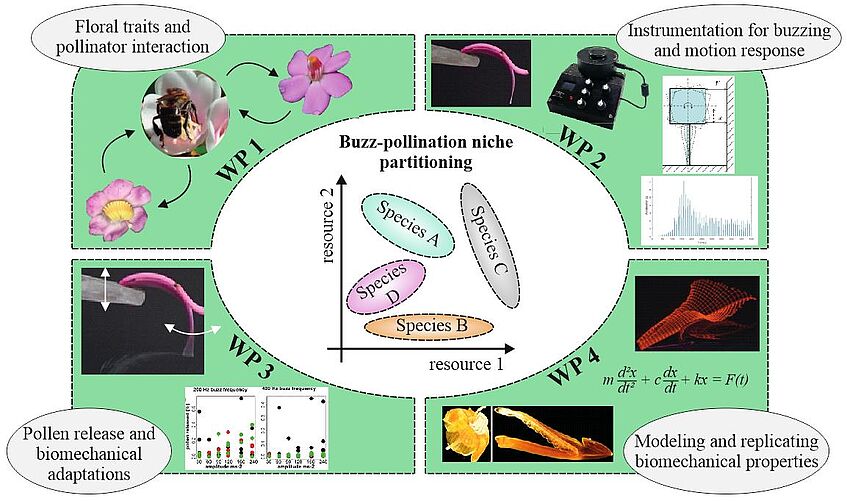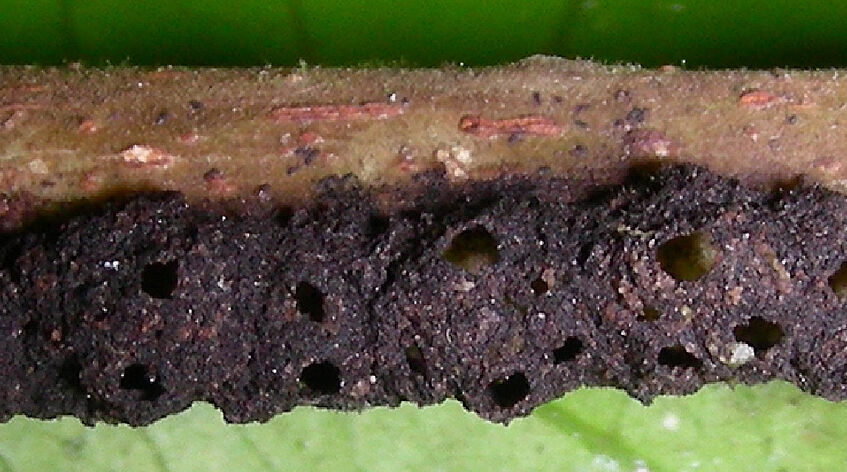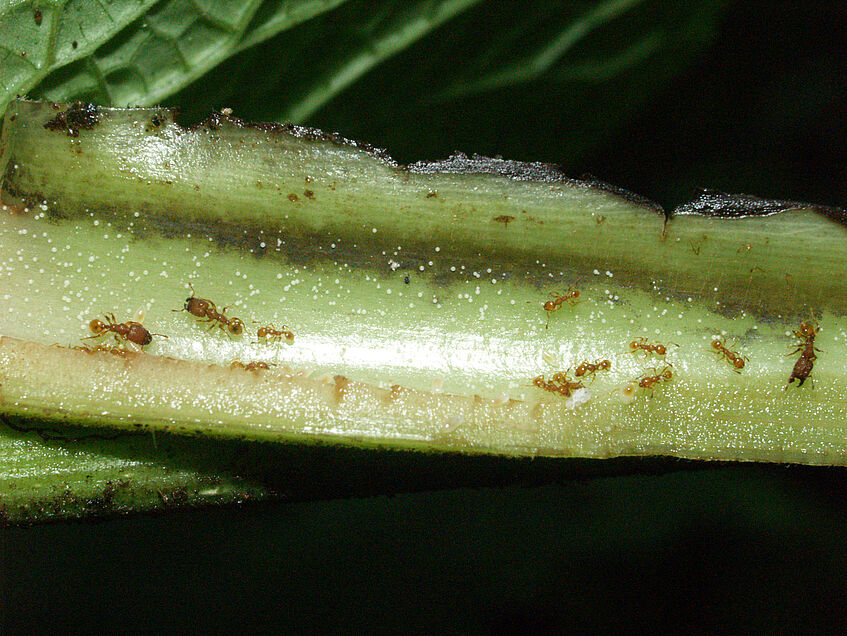Plant-Animal Interactions
Plant-animal-interactions represent an intersection between zoology and botany, and include all types of interactions between animals and plants. Negative interactions (e.g., parasitism), where one of the two interacting partners is affected negatively, are included as well as positive interactions (e.g., mutualisms, symbioses), where both partners benefit from the interaction, and neutral interactions (e.g., commensalism), where the interaction does not impact at least one of the partners. Well-known negative plant-animal-interactions include herbivory (e.g., caterpillars feeding on leaves) and carnivorous plants digesting insects. Positive interactions encompass the animal-mediated pollination of flowers and dispersal of fruits. Often, plant-animal interactions are not restricted to just two interacting partners, but instead characterized by complex, multitrophic networks; some plants, for example, form structures that provide housing and food for ants – the ants, in turn, defend the plants against herbivores, which would otherwise feed on these plants.
Plant-animal-interactions have a long research tradition, with a classic focus on negative interactions (e.g., the evolution of chemical defense strategies of plants and herbivores). Recently, the evolutionary and ecological importance of positive interactions is increasingly recognized. Positive (mutualistic) interactions do often represent crucial sources of biodiversity, and represent essential ecosystem services. Approximately 85% of flowering plants worldwide depend on pollination by animals, including many important crops. Fruit dispersal by animals represents another crucial ecosystem service, since animals may disperse heavy seeds to distant, new areas which plants could not reach on their own.
The research focus on plant-animal interactions in our division is centered on pollination biology (research group of A. Dellinger) and ant-plant interactions (research group of V. Mayer).
Research group Agnes Dellinger – Plant-Animal-Interactions

© A. Dellinger
Research group Agnes Dellinger – Plant-Animal-Interactions
Pollination biology, an essential mutualistic plant-animal interaction, is the main research focus of Agnes Dellinger’s group. Dellinger’s group is centered on exploring how plant-pollinator interactions are modulated across different (abiotic) environmental contexts (e.g., altitudinal gradients), and how these abiotic and biotic contexts contribute to plant diversification at macro- and microevolutionary scales. Within this framework, we are particularly interested in understanding how and when flowers diversify under continuous or divergent pollinator selection, and what conditions promote overlap or shifts in pollination niche space. The pantropical plant family Melastomataceae, encompassing more than 5.800 species and a large diversity of pollination systems (bees, hummingbirds, bats, rodents, passerines, generalistic insect pollinator assemblages) represents an ideal model system. The dominant pollination system in Melastomataceae is buzz-pollination, where bees apply specific vibrations to flowers to extract pollen. The structural and biomechanical properties of buzz-pollinated flowers, as well as the diverse interactions with bees remain poorly understood to date.
To address these interdisciplinary evolutionary and ecological questions, Dellinger and her students use a combination of observational and experimental fieldwork, morphological work in the lab, biomechanical and ecological modelling as well as phylogenetic comparative methods and population genomics. Current projects include modelling the abiotic and biotic drivers of diversification in Andean Melastomataceae, and the biomechanical characterization of buzz-pollination and assessment of buzz-bee pollinator diversity. In addition, there are ongoing collaborative projects on the evolution of flower and fruit colors and Master theses the pollination biology of European plants.
Research group Veronika Mayer – Ant-plant interactions

Carton gallery (© V. Mayer)

Piper opened domatium (© V. Mayer)
Research group Veronika Mayer – Ant-plant interactions
Ant-plant interactions are extremely abundant. They involve seed and fruit dispersal (myrmecochory), ant-protection associations (myrmecophyty), as well as seed robbing by harvester ants or the use of leaf material for fungus culture by leaf cutting ants. Ant-protection associations range from facultative and generalized to obligate and highly specialized. In facultative, generalized associations, plants secrete small volumes of nectar from nectaries outside the flowers, so-called extra-floral nectaries (EFNs). In specialized ant-plant associations non-pathogen cavities in hollow stems, branches, petioles, leaf pouches or rhizomes are provided by the plants serving as nesting space for the inhabiting ant colony. Very often, protein- and lipid-rich food is produced in specialized food bodies, famous examples are the Beltian bodies of the bull-horn Acacias, or the Müllerian bodies of the Cecropia species. In most cases, the ant-plant association is known to be a multispecies community with additional partners such as ant-tended coccids or fungi.
Specialized ant-plant associations are considerably rarer than generalized ones, but still are found in over 100 genera of tropical angiosperms (Davidson & McKey, 1993) and at least 20 plant families (O'Dowd, 1982). The specialized myrmecophytic ants have evolved in five of 12 subfamilies in the Formicidae. As Bronstein et al (2006) noted, growing evidence suggests that generalized ant-plant associations involve evolution primarily on the part of the plants, whereas in the more specialized myrmecophytic systems evolutionary processes are more often bilateral. Host selection mechanisms or olfactory cues for a quick acquisition of the defending ants evolved several times with different partners (e.g. Acacia-Pseudomyrmex, Cecropia-Azteca, Hirtella-Allomerus, Macaranga-Crematogaster, Piper-Pheidole). The evolutionary history and the traits under selection in both partners are interesting examples for the development and maintenance of mutualisms.
Research projects
- Flower biomechanics and the buzz-pollination niche (FWF-Project P 36766-B)
- Microbial community analysis in the neotropical ant-plant association: Azteca spp.-Cecropia spp.
- Modellierung a-/biotischer Faktoren einer Pflanzenradiation (Firnberg-Program Project T 1186-B)
- MountBuzz Project (ECR Starting Grant)
- Phylogeny and evolution of ant-cultivated Chaetothyriales (Ascomycota)
- Species interactions and their impact on nutrient recycling in ant-made fungal patches (FWF-Project P 31990-B) - finished
